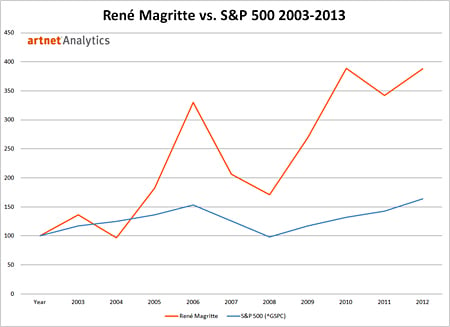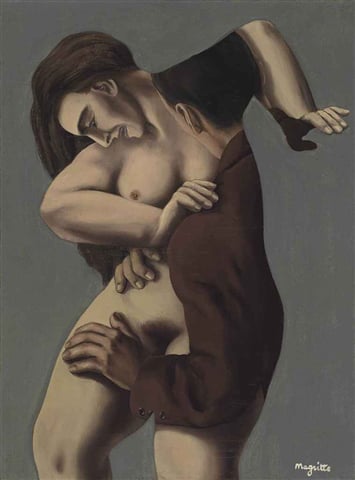Auctions
Artist Index: René Magritte
artnet Analytics takes a look at the market for artist René Magritte.

artnet Analytics takes a look at the market for artist René Magritte.

Lindsey Lovern and Jonathan Yee

The Surrealist work of artist René Magritte (Belgian, 1898–1967) will go on view at the MoMA in New York City. The exhibition, Magritte: The Mystery of the Ordinary, 1926–1938, on view September 28, 2013 through January 12, 2014, organized by MoMA, the Menil Collection, and the Art Institute of Chicago, will center around this early period of Magritte’s experimentation with Surrealism. To celebrate the exhibition, artnet Analytics is taking a look at the artist and his market.

René Magritte, Les jours gigantesque, 1928, oil on canvas, sold at Christie’s London
Magritte did not always focus his artistic vision on the works that many people often associate him with: isolated male figures adorned with bowler hats, smoking pipes with ironic captions, or boundless landscapes populated with displaced objects. Magritte’s earliest works, which date from the mid-1910s, follow the aesthetic tradition of the Impressionist movement. His work then evolved to incorporate stylistic elements of Cubism and Futurism, before experimenting with Surrealism in the mid-1920s.
The creation Le Jockey Perdu (1926) marked his entry into the Surrealist movement, the first phase of which lasted until the late 1930s. During this period, Magritte produced works that can be best described as dream-like, playing with themes of displacement, rationalism, and transformation. In 1929, Magritte painted The Treachery of Images (This is Not a Pipe), which became one of his most well-known works. The simplistic composition is packed with paradoxes and brings into question the relationship, or lack thereof, between an object, a visual representation of that object, and the verbal cue associated with the object.
During World War II, Magritte’s works were again subject to a switch in artistic vision as he embraced a painterly style reminiscent of Pierre-Auguste Renoir (French, 1841–1919). This “Renoir Period” lasted several years, and was followed by his “Vache (Cow) Period,” which was characterized by garish colors and grotesque figures. Finally, in 1948, he returned to the Surrealist themes and style he had adopted in the pre-war era. Magritte passed away in 1967, just as his recognition within the art world was taking off.

René Magritte vs. S&P 500, 2003–2013
Nearly 45 years after his death, the market for Magritte continues to show signs of significant growth. Since 2003, Magritte has outperformed the S&P 500, realizing gains of over 280%. Additionally, the 2013 auction season has already proved to be relatively strong for the artist as his top 10 lots of 2013 have totaled over US$36 million, with November sales still to come. This growth is bolstered by a high average sale price (US$1.7 million in 2013), and three consecutive years with strong sell-through rates (77% in 2011, 80% in 2012, and 81% in 2013). Finally, in 2012, Les jours gigantesques (1928) sold at Christie’s London for US$11.3 million, ranking second among his all-time highest prices achieved at auction.
For more information about the methodology of artnet Indices, please see the artnet Analytics White Paper.
Need additional analysis? artnet Analytics can work with you to create even more customized reports based on the specific needs of your auction house. For more information about custom reports, please contact Katharine Markley at [email protected]